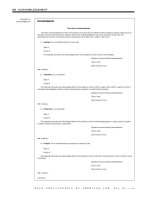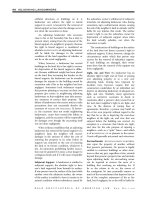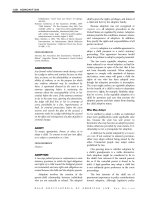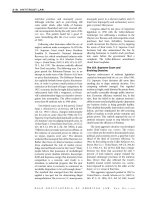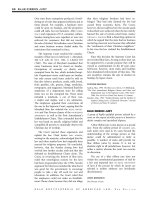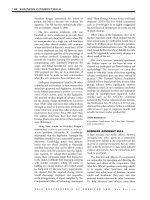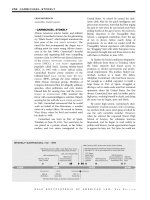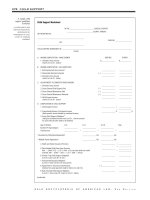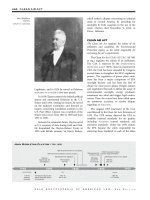Gale Encyclopedia Of American Law 3Rd Edition Volume 7 P9 potx
Bạn đang xem bản rút gọn của tài liệu. Xem và tải ngay bản đầy đủ của tài liệu tại đây (411.8 KB, 10 trang )
MILITARY OCCUPATION
Military occupation occurs when a belligerent
state invades the territory of another state with
the intention of holding the territory at least
temporarily. While hostilities continue, the
occupying state is prohibited by
INTERNATIONAL
LAW
from annexing the territory or creating
another state out of it, but the occupying state
may establish some form of military adminis-
tration over the territory and the population.
Under the
MARTIAL LAW imposed by this regime,
residents are required to obey the occupy ing
authorities and may be punished for not doing
so. Civilians may also be compelled to perform
a variety of nonmilitary tasks for the occupying
authorities, such as the repair of roads and
buildings, provided such work does not con-
tribute directly to the enemy war effort.
Although the power of the occupying army is
broad, the military authorities are obligated
under international law to maintain public order,
respect private property, and honor individual
liberties. Civilians may not be deported to the
occupant’s territory to perform forced labor nor
impressed into military service on behalf of the
occupying army. Although measures may be
imposed to protect and maintain the occupying
forces, existing laws and administrative rules are
not to be changed. Regulations of the Hague
Conventions of 1907 and, more importantly, the
1949
GENEVA CONVENTION for the Protection of
Civilian Persons in Time of War have attempted
to codify and expand the protection afforded the
local population during periods of military
occupation.
CROSS REFERENCE
War.
MILITIA
A group of private citizens who train for military
duty in order to be ready to defend their state or
country in times of emergency. A militia is distinct
from regular military forces, which are units of
professional soldiers maintained both in war and
peace by the federal government.
The U.S. Supreme Court has recognized that
the term militia has two meanings in the United
States, the “organized militia” and the “unorga-
nized militia.” District of Columbia v. Heller,—U.S.
—, 128 S.Ct. 2783, 171 L.Ed.2d 637 (2008). The
organized militia consists of the
NATIONAL GUARD.
The National Guard is made up of volunteer s and
acts under the dual authority of both the federal
and state governments. According to the Consti-
tution, Congress can call the National Guard into
federal service for three purposes: to enforce
federal laws, to suppress insurrections, and to
defend against invasions. State govern ors can call
upon the National Guard for emergen cies that are
prescribed by state law.
Unorganized militias consist of all able-
bodied men residing within the jurisdiction of a
particular state. From that pool of persons, the
Supreme Court has granted Congress plenary
power to organize the units in order to create an
effective fighting force. District of Columbia v.
Heller,—U.S.—, 128 S.Ct. 2783, 171 L.Ed.2d 637
(2008). In the first militia act, Congress specified
that “each and every free able-bodied white male
citizen of the respective states, resident therein,
who is or shall be of the age of eighteen years, and
under the age of forty-five years (except as is
herein after excepted) shall severally and respec-
tively be enrolled in the militia.” Act of May 8,
1792, 1 Stat. 271. In the early 2000s, the un-
organized militia of the United States consists of
all able-bodied males at least 17 years of age and,
with certain exceptions, under 45 years of age
who are, or who have made a declaration of
intention to become, citizens of the United States.
10 U.S.C. § 311.
The American militia system has its roots in
ancient English tradition, dating back to the
Anglo-Saxon militia that existed centuries before
the Norman Conquest in 1066. This militia,
known as the fyrd, consisted of every able-bodied
male of military age. It was traditionally used for
defense only, and the sovereign could call upon
the fyrd to fight if the men would be able to return
to their homes by nightfall. Fyrd members were
required to supply their own weapons, which
they could use only in the service of the king.
After 1066 the victorious Normans retained
this militia system, and successive English
monarchs continued to rely on citizen soldiers
for national defense. During the reign of the
Tudors (1485–1603), professional forces began
to be used in England. Their main task was to
train the local militias, which were much less
expensive to use than their professional coun-
terparts. The major element of training was the
muster—a mandatory gathering of all able-
bodied free males age 16 to 60, for the purpose
of appraising the participants, their weapons,
and their horses. Mustering was an ancient
ritual, but during her reign Queen Elizabeth I
systematized the practice. She req uired musters
GALE ENCYCLOPEDIA OF AMERICAN LAW, 3RD E DITION
68 MILITARY OCCUPATION
four times per year and authorized payment for
those who attended. Even with this enhanced
level of organization, musters were as much
social occasions as they were military drills.
Participants looked forward to musters as an
opportunity to eat and drink heavily before
engaging in fights and mock battles.
When the English began to establish colonies
in North America in the seventeenth century, the
colonial governments continued to require all
able-bodied free men to possess arms and to
participate in the colonial militias. Each colony
formed its own militia unit, appointing officers,
providing training, and building its own for-
tifications. The function of each colonial militia
was principally to defend the settlers’ homes and
villages against Indian raids.
Colonial militias were much less effective
when used for offensive purposes on extended
campaigns far from the militia members’ homes.
GEORGE WASHINGTON discovered this when, as a
colonel in the Virginia militia, he had great
difficulty recruiting enough men to fight the
French and Indian War (1754–63). Few men
were willing to report for duty. Of those who did,
few were well armed, and many quickly deserted
the troops and returned home . Some militia
officers instituted drafts to recruit more men,
but even then, many of the draftees simply paid
less-qualified men to report in their places. The
British were finally able to win the war when
Prime Minister William Pitt made changes in
recruiting policies and the military
BUREAUCRACY,
which made serving in the militia more palatable
for the American colonists.
After Great Britain defeated France in the
French and Indian War, it was left with a greatly
enlarged North American empire to manage
and finance. Large numbers of British troops
were stationed in America. The colonists were
expected to quarter them and to pay various
taxes and fees, including the well-known
STAMP
TAX
, to finance the troops. These additional taxes
were one of the principal grievances that
motivated the American colonists to prepare
for revolution and to form the select militia units
known as the “Minutemen.” This name reflected
the fact that the men were trained to respond
instantly when called. The Minutemen first saw
action when the Massachusetts unit was called to
defend the colonists’ military stores at Lexington
and Concord on April 19, 1775.
During the Revolutionary War American
military forces consisted of a combination of
state militias; specially trained militia units (such
as the Minutemen); and the Continental Army,
a small professional force created by Congress.
The militia was much more effective than it had
been during the French and Indian War because
its members were fighting for a cause in which
they believed. In addition, the militia system had
been reorganized and strengthened: There were
more training days, the punishment was more
severe for missing musters , and fewer men were
exempted from military duty. Even so, militia
forces were much less reliable than the profes-
sional army, and commanders found it difficult
to plan their moves, never knowing exactly how
many men would show up and how long they
might stay. Ultimately, the militias played a
critical role in helping the colonists to defeat the
British, supplying enough men to keep the
Continental Army going and providing—on
very short notice—large numbers of armed men
for brief periods of emergency service.
When state delegates met in 1787 to create
the Constitution for the new United States of
America the principal division was between those
delegates who favored a strong central govern-
ment and those who preferred to leave more
power to the states. The former wanted a strong
standing military, and the latter argued for greater
reliance on the state militias. The issue of a
standing military was particularly controversial
because many Americans were suspicious of the
very concept of a standing army, associating it
with the tyranny they had experienced under
Great Britain. Nevertheless, because most of the
delegates were more concerned about invasion
than domestic tyranny, Congress was given the
power to create a standing army if it so chose.
Advocates of state power did achieve a partial
victory, however, in that authority over the state
militias was divided between the federal govern-
ment and the state governments. Congress was
given the authority to organize, arm, and
discipline the militia, but states were given the
power to appoint officers and provide training.
Congress, not the president, was given the power
to summon state militias into federal service for
just three specific tasks: “to execute the laws of the
Union, suppress insurrections, and repel inva-
sions” (Art.I,Sec.8,Cls.15,16).
Uniform Militia Act
During his first term as president, George
Washington worked with Secretary of War
Henry Knox to reorganize and strengthen the
militia. They sent their plan to Congress where
GALE ENCYCLOPEDIA OF AMERICAN LAW, 3RD E DITION
MILITIA 69
there was heated debate. Finally, on May 9,
1792, Congress passed what became known as
the Uniform Militia Act (1 Stat. 264). This law
remained the basic militia law until the twenti-
eth century. It stated that all free, able-bodied
white men, age 18 to 45, were required to serve
in their state militias and they were obligated to
supply themselves with the appropriate firearms
and equipment. The law provided certain
specifications for how militia units were to be
organized, but Congress left many details to the
states and declined to include sanctions for states
or individuals who failed to comply with the law.
As a result, the act had little legal weight and
served mostly as a recommendation to the states.
All 15 states passed laws in response to the
Uniform Militia Act. These laws had some
provisions in common, such as the right of the
people to keep and bear arms and the exemp-
tion of conscientious objectors from military
duty. The laws varied in other areas, such as in
the frequency of training and the methods for
selecting officers. In general, the Uniform
Militia Act and the laws passed in response to
it created many strong and effective state
militias. In addit ion to being an indispensable
part of ceremonies and parades , state militia
units manned coastal forts, guarded criminals,
enforced quarantines, and assisted the police.
However, the many state laws prevented the
INTEGRATION of the various state militias into a
reliable force for federal purposes. The federal
government often lacked even basic informa-
tion about the strength and organization of the
state militias, making it difficult to make full use
of them for military purposes.
Despite the many weaknesses of the militia
system, it continued to receive widespread
support in the nineteenth century from politi-
cians and the public, who were eager to avoid
the expense of a standing army and who viewed
the idea of the citizen-soldier as crucial for the
maintenance of U.S. freedo m and indepen-
dence. In reality, the militia system was often
ineffective and unreliable. During the
WAR OF
1812, for example, militia units were chronically
undermanned and poorly prepared. Despite
calls for reforms, the militia system declined
steadily during the nineteenth century. Less
training was required, fewer men attended, and
fewer still had firearms, instead showing up for
training with cornstalks and broomsticks.
By the 1830s and 1840s, several states had
weakened or abolished their systems of
compulsory service, relying instead on volun-
teers. As a result, the militia units became more
ceremonial and elitist in nature; members
donned expensive uniforms and equipment to
march in parades and other festivals. These
volunteer units were useful to state and local
authorities because they often assisted the local
police in maintaining law and order, which
were frequently disrupted by riots and protests,
particularly in larger cities.
After the Civil War, in which militia units
played a crucial role by supplementing the regular
armies of both the Union and the
CONFEDERACY,
the militia system again went into a decline. A
shortage of funds required cutbacks in militia
programs, and military service became more
unattractive as the rapid growth of industrialism
led to frequent labor strikes, which the Army was
required to police. Ac cording to Russell F.
Weigley, a prominent military historian, “The
main effect of industrialism seems to have been to
reduce inclination and time for amateur soldier-
ing, and thus to weaken the militia institutions
inherited from the rural past.”
Formation of the National Guard
One rejuvenating factor for the militia during
this time was the formation of the National
Guard Association (NGA) in 1879. This organi-
zation was formed to represent the militia’s
interests before federal and state governments
and the public. The name “National Guard” was
chosen because most states at the time were
already using that term to designate their
organized volunteer companies. The leaders of
the NGA insisted that their units were an
integral part of the U.S. militar y establishment
but also maintained the importance of the
guard’s connection to individual states. In 1887
the NGA achieved its first victory by persuading
Congress to raise the federal annual
APPROPRIA-
TION
to arm the guard to $400,000.
At the beginning of the twentieth century,
Congress and President
WILLIAM MCKINLEY began
work to reform the nation’s military structure
and operations. Secretary of War Elihu Root
saw that the United States needed a workable
reserve system, rather than the militia, which
still operated under the Uniform Militia Act of
1792. Root worked with leaders from the NGA
to create a
REORGANIZATION PLAN and the result
was the passage of the Dick Act (32 Stat. 775) in
1903. The act was named for Major General
Charles Dick who had played a large role in
creating and supporting the bill. This act
GALE ENCYCLOPEDIA OF AMERICAN LAW, 3RD E DITION
70 MILITIA
formally repealed the Uniform Militia Act of
1792 and extended federal involvement with the
National Guard in peacetime. More federal
funds were made available to state National
Guard units, and in return the state units were
required to drill their troops 24 times a year,
train reservists in summer encampments, and
submit to annual inspections by federal officers.
In the years leading up to
WORLD WAR I,
professional officers in the regular army and
leaders of the National Guard consistently
opposed each other on the issue of establishing
a national reserve free from all ties to the states.
The NGA contended that National Guard units
were the proper national reserve, but military
professionals argued that national security could
not depend on reserves that had two comman-
ders-in-chief and two chains of command—
federal and state. In congressional hearings held
in 1916, then ex-Secretary of War Root argued
against the guard as a reliable reserve: “The
idea that forty-eight different governors can
be the basis for developing an efficient, mobile
national army is quite absurd.”
Proponents of a national reserve won the
debate. On June 3, 1916, President
WOODROW
WILSON
signed the National Defense Act (39 Stat.
166) that for the first time created reserve
components of the regular services under exclu-
sive federal control. The act also conferred federal
status on the National Guard, with the federal
government providing more funding and exert-
ing more control over it. National Guard units
still reported to the state governors and served on
a statewide basis, but guardsmen could now be
drafted directly into federal service for the
duration of an emergency. Guard members had
to take loyalty oaths to the United States as well as
to their home states, and the War Department
could cut federal aid to the guard unit of any state
that failed to comply with the mandates of the act.
This basic system established in 1916 has
continued to be maintained with few changes
over the course of the twentieth century. The
state National Guard units report to both the
state and federal governments, but when they
are called into federal service, state governors
lose their authority over them. This state and
federal authority conflicted several times in the
1950s and 1960s when guard units from
southern states were called into federal service
to enforce federal desegregation mandates over
the objections of the state governors.
Private Militias
Private militias are not officially recognized by
federal or state governments. They are composed
of private citizens who train for armed combat.
The formation of private militias became more
common in the United States during the 1990s as
some political groups armed themselves to
demonstrate their opposition to certain policies
and practices of the federal government. For
example, the Montana Freemen were a private
militia group involved in a lengthy standoff with
agents of the
FEDERAL BUREAU OF INVESTIGATION (FBI)
in 1996. The standoff ended peacefully with no
bloodshed or loss of life, though several militia
members were subsequently convicted and sen-
tenced to prison for various crimes including
CONSPIRACY,bankFRAUD,andwirefraud.
The Oklahoma City Bombing in 1995, which
killed 169 people, also had a significant impact on
the popularity and perception of private militias
in the United States. The attack was carried out by
anti-government militia sympathizers Timothy
McVeigh and Terry Nichols (McVeigh was later
convicted and executed, while Nichols was
sentenced to life in prison without the possibility
of
PAROLE). At the time of the bombing, a federal
government report revealed the existence of 858
domestic militias in the United States. Shortly
after the bombing, the FBI hired an additional
500 agents to investigate these groups, while
legislatures in more than 25 states enacted laws
prohibiting unauthorized private militias and
other groups engaged in paramilitary training.
By 2004 the total number of such groups had
declined to approximately 152. Law enforcement
officials continue to track militia, citing their
extremist beliefs and their propensity for con-
spiring to commit acts of violence.
FURTHER READINGS
Fields, William S., and David T. Hardy. 1992. “The Militia
and the Constitution: A Legal History.” Military Law
Review 136 (spring).
Freilich, Joshua D. 2003. American Militias: State-Level
Variations in Militia Activities. New York: LFB Scholarly
Pub. LLC.
Hardaway, Robert, Elizabeth Gormley, and Bryan Taylor.
2002. “The Inconvenient Militia Clause of the Second
Amendment: Why the Supreme Court Declines to
Resolve the Debate over the Right to Bear Arms.”
St. John’s Journal of Legal Commentary 16 (winter):
41–146.
Huhn, Wilson. 1999. “Political Alienation in America and
the Legal Premises of the Patriot Movement.” Gonzaga
Law Review 34 (spring): 417–43.
Mahon, John K. 1983. History of the Militia and the National
Guard. New York: Macmillan.
GALE ENCYCLOPEDIA OF AMERICAN LAW, 3RD E DITION
MILITIA 71
Maslowski, Peter, and Allan R. Millett. 1994. For the
Common Defense: A Military History of the United
States. New York: Free Press.
Mulloy, D. J. 2004. American Extremism: History, Politics and
the Militia Movement. London, New York: Routledge.
Uviller, H. Richard, and William G. Merkel. 2002. The
Militia and the Right to Arms, or How the Second
Amendment Fell Silent. Durham, NC: Duke Univ. Press.
Weigley, Russell F. 2000. A Great Civil War: A Military and
Political History. Bloomington, IN: Indiana Univ. Press.
———
. 1975. New Dimensions in Military History. Novato,
CA: Presidio.
———
. 1967. History of the United States Army. New York:
Macmillan.
Wolfson, Andrew. 2001. “Militias Dwindle since Oklahoma
City Bombing.” USA Today. Available online at
www.usatoday.com/news/nation/2001-04-23-mcveigh
militias1.htm (accessed October 4, 2003).
CROSS REFERENCES
Alcohol; Armed Services; Federal Bureau of Investigation;
Gun Control; Military Law; Oklahoma City Bombing;
Second Amendment; Second Amendment “Private Militias”
(In Focus); Tobacco, Firearms, and Explosives, Bureau of
MILL
One-tenth of one cent: $0.001. A mill rate is used
by many localities to compute property taxes. For
example, some states levy a one-time nonrecurring
tax of two mills per dollar (0.2%) on the fair market
value of all notes, bonds, and other obligations for
payment of money that are secured by mortgage,
deed of trust, or other lien on real property in lieu of
all other taxes on such property.
v
MILL, JOHN STUART
John Stuart Mill was the leading English
political philosopher of the middle and late
nineteenth century. Mill’s writings on individu-
al freedom, most notably the essay “On Liberty”
(1859), have had a profound influence on U.S.
CONSTITUTIONAL LAW.His“libertarian theory”
continues to attract those opposed to govern-
ment interference in the lives of individuals.
Mill was born on May 20, 1806, in London.
His father, James Mill, was a leading proponent
of
UTILITARIANISM, a political theory that claimed
that the greatest happiness of the greatest
number should be the sole purpose of al l public
action. James Mill provided his son with an
unorthodox but extensive education. John
Mill began studying Greek at the age of
three, and by the age of 17 he had completed
advanced courses in science, philosophy,
psychology, and law.
In 1822 Mill began working as a clerk for his
father at India House, the large East Indian
trading company. He rose to the position of
chief of the examiner’s office and stayed with
the company until his retireme nt in 1858.
Mill’s real passion, however, was political
and social philosophy. In 1826 he had a serious
mental crisis that caused him to reevaluate the
tenets of utilitarianism and to reconsider his
own purpose and aim in life. At the same time,
he became acquainted with Harriet Taylor, a
gifted thinker who would become Mill’s collab-
orator and later his wife. Largely ignored by
historians, Taylor is now credited as a major
contributor to Mill ’s published works.
Mill’s essay “On Liberty” remains his major
contribution to political thought. He proposed
that self-protection is the only reason an
individual or the government can interfere with
a person’s liberty of action. Outside of prevent-
ing harm to others, the state has no legitimate
reason to compel a person to act in the way the
government wishes. This principle has proved
complex in application, because it is difficult to
determine which aspects of behavior concern
only individuals and which concern other
members of society.
In chapter two of “On Liberty,” Mill
considered the benefits that come from
FREEDOM
John Stuart Mill 1806–1873
❖
❖
◆
1806 Born,
London, England
◆
1822 Began work
as clerk at India
House trading
company
1861–65
U.S. Civil War
1843 A
System
of Logic
published
▼▼
▼▼
18001800
18501850
18751875
18251825
1865–68
Served in
Parliament
1856 Became
chief of office
at India House
1873 Died,
Avignon, France
◆◆
◆
◆
1863
Utilitarianism
published
1812–14
War of 1812
◆
1848 Principles
of Political
Economy
published
◆◆
1831 Began
twenty-year
professional
collaboration with
Harriet Taylor
1859 "On Liberty" published
1858 Retired from India House
1869 The
Subjection of
Women
published
THE WORTH OF A
STATE
, IN THE LONG
RUN
, IS THE WORTH
OF THE INDIVIDUALS
COMPOSING IT
.
—JOHN STUART MILL
GALE ENCYCLOPEDIA OF AMERICAN LAW, 3RD E DITION
72 MILL
OF SPEECH. He concluded that, except for speech
that is immediately physically harmful to others
(like the classic example of the false cry of “fire”
in a crowded theater, cited by
OLIVER WENDELL
HOLMES JR
.), no expression of opinion, written or
oral, oug ht to be prohibited. Truth can only
emerge from the clash of contrary opinions;
therefore, robust debate must be permitted.
This “ adversarial” theory of the necessary
nature of the search for truth and this insistence
on the free marketplace of ideas have become
central elements of U.S. free speech theory.
Mill also applied his principle of liberty to
action as well as speech. Mill believed that
“experiments of living” maximize the develop-
ment of human individuality. Restraints on
action should be discouraged, even if the actions
are inherently harmful to the individuals who
engage in the m. Mill claimed that society should
not be allowed to prohibit fornication, the
consumption of alcohol, or even
POLYGAMY.
Mill asserted the i mportance of personal
development and the negative impact of
conditioning and conformity which he believed
tended to stunt or stifle individual development.
The liberty he proclaimed was one in which all
individuals are equally free to develop innate
talents and abilities. He assumed that indivi-
duals will naturally tend to be drawn toward
what they are good at doing and this natural
ability, freely allowed to develop, enhances and
contributes to all society.
Mill’s other works include A System of Logic
(1843), Principles of Political Economy (1848),
The Subjection of Women (1869), and Autobiog-
raphy (1873).
Mill served in Parliament from 1865 to
1868. He was considered a radical because he
supported the public ownership of natural
resources, compulsory education,
BIRTH CON-
TROL
, and social and legal equality for women.
His advocacy of women’s suffrage contributed
to the creation of the suffrage movement. Mill
died on May 7, 1873, in Avignon, France.
FURTHER READINGS
Capaldi, Nicholas. 2004. John Stuart Mill: A Biography. New
York: Cambridge Univ. Press.
Mill, John Stuart. 2008. The Autobiography of John Stuart
Mill. Rockville, MD: Arc Manor.
Ofseyer, Jeremy J. 1999. “Taking Liberties with John Stuart
Mill.” Annual Survey of American Law 1999 (fall).
Packe, Michael St. John. 1954. The Life of John Stuart Mill.
New York: Macmillan.
Passavant, Paul A. 1996. “A Moral Geography of Liberty:
John Stuart Mill and American Free Speech Discourse.”
Social & Legal Studies 5 (September).
Rose, Phyllis. 1984. Parallel Lives: Five Victorian Marriages.
New York: Vintage.
Ten, Chin Liew, ed. 1999. Mill’s Moral, Political, and
Legal Philosophy. Aldershot, Hampshire, England:
Ashgate.
CROSS REFERENCES
Bentham, Jeremy; Libertarianism; Utilitarianism.
v
MILLER, LOREN
Loren Miller was a municipal court judge and
housing discrimination specialist whose in-
volvement in the early stages of the
CIVIL RIGHTS
MOVEMENT
earned him a reputation as a tena-
cious fighter for equal housing opportunities for
minorities.
Miller was born Jan uary 20, 1903, in
Pender, Nebraska, the son of a post–Civil War
Loren Miller 1903–1967
❖
❖
◆
1903 Born,
Pender, Neb.
1928 Earned LL.B. from
Washburn University,
Kansas; admitted to
Kansas bar
1954 Became owner
and publisher of
the California Eagle
1914–18
World War I
1967 Died,
Los Angeles, Calif.
1933
Admitted to
California bar
1961–73
Vietnam War
1939–45
World War II
1956–60 Served
on NAACP's
National Legal
Committee
and its
National Board
of Directors
1950–53
Korean
War
▼▼
▼▼
19001900
19501950
19751975
19251925
1948 Supreme Court struck down racially
restrictive land covenants in Shelly v. Kraemer
◆
◆
1966 The Petitioners:
The Story of the Supreme
Court of the United States
and the Negro published
1964–67 Served on Superior
Court of California
1929–33 Worked for California News
◆
◆
1961–66 Served as
vice president of the NAACP
1954 Supreme Court
decided Brown v.
Board of Education
◆
GALE ENCYCLOPEDIA OF AMERICAN LAW, 3RD E DITION
MILLER, LOREN 73
migrant from the South. His family moved to
Kansas when he was a boy, and he graduated
from high school in Highland, Kansas. Later,
he attended the University of Kansas; Howard
University; and Washburn University, in
Topeka, Kansas, where he earned his bachelor
of laws degree in 1928. He was admitted to the
Kansas bar the same year, and practiced law
there for one year before moving to California
to pursue his first interest, journalism. He
worked for the California News, a Los Angeles
newspaper, from 1929 to 1933.
Miller returned to the field of law when he
married and was admitted to the California bar
in 1933. By the 1940s he was raising his voice in
protest over policies and practices that discrim-
inated against African Americans. In the wake
of
WORLD WAR II, many blacks had left their rural
and southern homes to seek economic oppor-
tunity in California, only to face discrimination
and bias, part icularly in housing. By 1947
Miller had represented more than 100 plaintiffs
seeking to invalidate housing covenants that
prevented blacks from purchasing or renting
housing in certain areas. As a board member of
the
AMERICAN CIVIL LIBERTIES UNION (ACLU), he
became a well-known spokesman for the rights
of minorities to enjoy equal access to housing
and education. He was openly critical of the
Federal Housing Authority (FHA), declaring
that FHA policies fostered a Jim Crow policy
that kept blacks confined to “tight ghettos” and
provoked racial tens ion. Commenting on the
effect of racially restrictive covenants, he noted
that contrary to the claims of those who
supported the covenants, residential
SEGREGA-
TION
did not preserve public peace and GENERAL
WELFARE
but rather resulted in “nothing but
bitterness and strife.”
In 1954 Miller’s love of journalism promp-
ted his return to the newspaper business. He
became the owner and publisher of the Cali-
fornia Eagle, a weekly newspaper with wide cir-
culation in the African American community.
He also contributed numerous articles to such
journals as the Crisis, the Nation, and Law in
Transition. Later, Miller was named cochair
of the West Coast legal committee of the
National Association for the Advancement of
Colored People (
NAACP). In that capacity, he
became the first U.S. lawyer to win an
unqualified verdict outlawing residential restric-
tive covenants in real estate sales that involved
FHA or
VETERANS ADMINISTRATION (VA) financ-
ing. Perhaps the most celebrated case Miller was
involved in was Shelley v. Kraemer, 334 U.S. 1,
68 S. Ct. 836, 92 L. Ed. 1161 (1948), in which
the U.S. Supreme Court declared that racial
covenants on property cannot be enforced by
the courts.
Miller was one of the first to recognize that
bias in housing would be an explosive social
issue in the United States. The greatest tension,
he predicted, would exist where an all-white
area adjoined an all-black area, because “there
white Americans stand eternal guard to keep
their Negro fellow Americans out.” He de-
nounced as “money lenders” and “hucksters of
prejudice” the owners of slum properties where
many membe rs of minoriti es are forced to live
under substandard conditions because of the
“artificial housing shortages in the Negro
community.”
In 1964 Governor Edmund G. Brown of
California appointed Miller to the Superior
Court of California, where he served until his
death. He was vice president of the NAACP
(1961–66); a member of the NAACP’s National
Legal Committee and of its National Board of
Directors (1956–60); a member of the national
committee of the ACLU; and vice president of
the National Bar Association, an organization of
African American attorneys. Miller was also a
member of the California Advisory Commis-
sion on Civil Rights, vice president of the
National Committee against Discrimination in
Housing, and a member of the
NAACP LEGAL
DEFENSE AND EDUCATIONAL FUND
.
In 1966 Miller wrote The Petitioners: The
Story of the Su preme Court of the United States
and the Negro, a book that recounts the vital
role of the U.S. Supreme Court in shaping the
lives of African Americans in the U.S. He and
his wife, Juanita Ellsworth Miller, had two sons,
Loren Jr., and Edward. Miller died in Los
Angeles on July 14, 1967.
v
MILLER, SAMUEL FREEMAN
Samuel Freeman Miller served as an associate
justice of the U.S. Supreme Court from 1862 to
1890. During his long tenure on the Court,
Miller played a major role in restricting the
reach of the
FOURTEENTH AMENDMENT into areas
of the law reserved to the states. He is most
famous for writing the majority opinion in the
THE NEGRO HAS
BEEN THE WARD OF
THE
SUPREME
COURT OF THE
UNITED STATES FOR
MORE THAN A
HUNDRED YEARS
.
—LOREN MILLER
GALE ENCYCLOPEDIA OF AMERICAN LAW, 3RD E DITION
74 MILLER, SAMUEL FREEMAN
SLAUGHTER-HOUSE CASES, 83 U.S. (16 Wall.) 36, 21
L. Ed. 394 (1873).
Miller was born on April 5, 1816, in
Richmond, Kentucky, and grew up on a farm.
He attended Transylvania University, where
he earned a medical degree in 1838. Miller
practiced medicine for ten years, and during
that time he taught himself law. In 1847 he
was admitted to the Kentucky bar, and soon
afterward he abandoned his medical practice for
a law practice in Knox County, Kentucky.
Miller became more interested in politics
after he became an attorney. A member of the
WHIG PARTY, Miller was opposed to SLAVERY,a
position that caused him difficulty in Kentucky
as pro-slavery sentiment began to rise. In 1850
he moved to Iowa, which was more tolerant of
his antislavery views. He established a law
practice in Keokuk, Iowa, and became a promi-
nent member of the
REPUBLICAN PARTY and a
supporter of Abraham Lincoln’s presidential
campaign in 1860.
Lincoln appointed Miller to the U.S.
Supreme Court in 1862, during the most
difficult period for the Union during the Civil
War. Miller voted to sustain Lincoln’s suspen-
sion of
HABEAS CORPUS and to try civilians by
military courts-martial. Following the war,
Miller voted to uphold the constitutionality of
LOYALTY OATHS that were required of former
Confederates who wished to hold public office.
Miller is best known for his majority
opinion in the Slaughter-House Cases in 1873.
At issue was the scope of the authority in the
Fourteenth Amendment, which had been
passed in 1868 to guarantee that states could
not restrict the constitutional rights of citizens
and businesses. The case involved a Louisiana
state law that allowed one meat company
the exclusive right to slaughter livestock in
New Orleans. Other packing companies were
required to pay a fee for using the slaughter-
houses. Those companies filed suit, claiming
that the law violated the
PRIVILEGES AND IMMUNI-
TIES CLAUSE
of the Fourteenth Amendment,
which stated that “no state shall make or
enforce any law which shall abridge the
privileges or immunities of citizens of the
United States.”
Miller upheld the Louisiana
MONOPOLY law,
ruling that the Privileges and Immunities Clause
had a limited effect because it only reached
privileges and immunities guaranteed by U.S.
citizenship, not state citizenship. The law in
question concerned state rights; therefore, the
Fourteenth Amendment had no effect. In
Samuel F. Miller.
LIBRARY OF CONGRESS
Samuel Freeman Miller 1816–1890
❖
1816 Born,
Richmond, Ky.
◆
1838 Earned M.D.
from Transylvania
University, Ky.
1861–65
U.S. Civil War
▼▼
▼▼
18001800
18501850
18751875
19001900
18251825
1873 Wrote majority opinion in
Slaughter-House Cases, which
limited the scope and effect of
the Fourteenth Amendment
◆
1883 Voted with majority in Civil
Rights Cases, which held that
private discrimination was not
unconstitutional
1812–14
War of 1812
1847
Admitted to
Ky. bar
1862–90 Served
on U.S. Supreme
Court
◆
❖
1890 Died,
Washington, D.C.
◆ ◆
1876 Served on
electoral
commission that
decided the
disputed Hayes-
Tilden election
IT DOES
NOT FOLLOW
, THAT
WHEN A WORD WAS
USED IN A
STATUTE SEVENTY
YEARS SINCE
, THAT IT
MUST BE HELD TO
INCLUDE EVERYTHING
TO WHICH THE SAME
WORD IS APPLIED AT
THE PRESENT DAY
.
—SAMUEL MILLER
GALE ENCYCLOPEDIA OF AMERICAN LAW, 3RD E DITION
MILLER, SAMUEL FREEMAN 75
Miller’s view, the Fourteenth Amendment was
designed to grant former slaves legal equality,
and not to grant expanded rights to the general
population. In addition, Miller was concerned
that a broad interpretation of the Fourteenth
Amendment would give too much power to the
federal government and that it could distort the
concept of
FEDERALISM, which grants the states a
large measure of power and autonomy.
Having set the standard for interpreting the
Fourteenth Amendment, Miller and most
members of the Court followed it dur ing the
1870s and 1880s. Miller and the Court struck
down state-sponsored
RACIAL DISCRIMINATION
under the amendment but refused to do the
same to private discrimination, most notably in
the
CIVIL RIGHTS CASES, 109 U.S. 3, 3 S. Ct. 18, 27
L. Ed. 835 (1883). In these cases, the Court held
that federal laws that banned private discrimi-
nation in public transportation and public
accommodation were unconstitutional because
the Fourteenth Amendment only reaches state-
enacted discrimination.
In a nonjudicial role, Miller served on
the electoral commission that counted the
electoral votes in the deadlocked and dis-
puted presidential election of 1876 between
RUTHERFORD B. HAYES and SAMUEL J. TILDEN. During
the 1880s some Republican leaders promoted
Miller as a presidential candidate, but nothing
came of it. Miller died on October 13, 1890, in
Washington, D.C.
RESOURCES
Fairman, Charles. 2003. Mr. Justice Miller and the Supreme
Court, 1862&1890. Clark, NJ: Lawbook Exchange.
Hall, Kermit L. 2005. Oxford Companion to the Supreme
Court of the United States. 2d ed. New York: Oxford
Univ. Press.
Ross, Michael A. 2003. Justice of Shattered Dreams: Samuel
Freeman Miller and the Supreme Court during the
Civil War Era. Baton Rouge: Louisiana State Univ.
Press.
CROSS REFERENCE
States’ Rig hts.
MILLER V. CALIFORNIA
Arguably the most important in a series of late-
twentieth-century Supreme Court cases laying
down the definition of
OBSCENITY and setting
down the boundaries as to how and when
communities could regulat e obscene materials.
Miller v. California, 413 U.S. 15, 93 S. Ct. 2607,
37 L. Ed. 2d 419 (1973) remained the Supreme
Court’s final word on most types of
PORNOGRA-
PHY
into the twenty-first century. Whereas the
test set down for defining obscenity in Miller v.
California has been modified and expanded by
subsequent court cases since the original
decision was handed down in 1973, it has never
been overturned and forms the starting point
for nearly all U.S. court cases dealing with
obscenity prosecutions.
Pre-Miller Obscenity Cases
Miller v. California and its companion case,
Paris Adult Theatre I v. Slaton, 413 U.S. 49, 93 S.
Ct. 2628, 37 L. Ed. 2d 446, (1973), marked the
culmination of a period when the Supreme
Court laid down several tests for obscenity, the
most famous and succinct of which was Justice
Potter Stewart’s comment in his concurrence in
Jacobellis v. State of Ohio 378 U.S. 184, 84 S. Ct.
1676, 12 L. Ed. 2d 793 (1964), “I know it when I
see it.” For years, U.S. courts had generally
followed the definition of obscenity contained
in the 1868 British case, Regina v. 3 L.R Q.B.
360 (1868). That case said the definition of
obscenity was “whether the tendency of the
matter charged is to deprave and corrupt those
whose minds are open to such immoral
influences and into whose hands a publication
of this sort may fall.” Courts differed as to
whether just one passage of the material was
sufficient to prove this tendency or whether the
work had to be examined as a whole.
But in 1957 the Supreme Court explicitly
rejected Regina v. Hicklin in
ROTH V. UNITED
STATES
354 U.S. 476, 77 S. Ct. 1304, 1 L. Ed. 2d
1498,(1957). In that case, a divided Supreme
Court first ruled for the first time that obscenity
was beyond constitutional protection. The
Court went on to rule that the new standard
for judging obscenity was whether to an average
person, applying contemporary community
standards, the dominant theme of material
taken as a whole appealed to prurient interest.
In imposing an average person standard, the
Court departed from Hicklin’smorebroad
definition to allow a finding of obscenity
wherever there were “minds open to immoral
influences.”
Unfortunately, the Supreme Court’s obscen-
ity test in Roth seemed to create more problems
than it solved, for both lower courts and the
high court itself, partially because it proved
difficult to determine who the average person in
a community was and whether local, state, or
GALE ENCYCLOPEDIA OF AMERICAN LAW, 3RD E DITION
76 MILLER V. CALIFORNIA
national standards were to be applied in trying
to divine this person. Also, measuring the
dominance of obscenity within a piece of material
was not an easy task for most courts. In ABook
Named ‘John Cleland’s Memoirs of a Woman of
Pleasure’ v. Attorney General of Massachusetts, 383
U.S. 413, 86 S. Ct. 975, 16 L. Ed. 2d 1, (1966), the
high court further added that the material in
question had to be utterly without redeeming
social value, a standard that many prosecutors
complained was almost impossible to meet.
With all the confusion, the stage was set for
the court to make a definitive statement on
obscenity. This is what the court tried to do in
Miller v. California. But for years after the
decision was handed down, commentators
debated whether the court had succeeded.
Miller v. California
Under a California obscenity statute, Marvin
Miller was convicted for mailing illustrated
brochures advertising “adult ” books. The Cali-
fornia appeals court used the tests previously
enunciated by the court to uphold Miller’s
conviction. The Supreme Court took up the
case as an opportunity to reconsider its previous
holdings.
The resulting 5–4 decision imposed a new test
for determining obscenity. In a decision written
by Chief Justice
WARREN BURGER,theCourt
imposed a new three-part test for determining
whether a work was obscene. Burger wrote: “The
basic guidelines for the trier of fact must be:
(a) whether ‘the average person, applying con-
temporary community standards’ would find that
the work, taken as a whole, appeals to the
prurient interest, (b) whether the work depicts or
describes, in a patently offensive way, sexual
conduct specifically defined by the applicable
state law; and (c) whether the work, taken as a
whole, lacks serious literary, artistic, political, or
scientific value.”
In handing down this decision, Burger
reaffirmed that obscenity and pornography are
not protected by the
FIRST AMENDMENT.He
explicitly rejected the “utterly without redeem-
ing social value” test in favor of the third prong
of his formula, which was viewed as an easier
standard for prosecutors to meet. He also
stated that no one could be subjected to
prosecution “for the sale or exposure of obscene
materials unless these materials depict or
describe patently offensive ‘hardcore’ sexual
conduct specifically defined by the regulating
state law, as written or construed.”
Burger went further than past Supreme
Court decisions in attempting to define w hat
would constitute hardcore pornography. While
emphasizing that “it is not our function to
propose regulatory schemes for the States” he
said that “It is possible to give a few plain
examples of what a state statute could define for
regulation: (a) patently offensive representa-
tions or descriptions of ultimate sexual acts,
normal or perverted, actual or simulated; and
(b) patently offensive rep resentation or descrip-
tions of masturbation, excretory functions, and
lewd exhibition of the genitals.”
The companion case of Paris Adult Theatre I
v. Slaton, handed down on the same day, ruled
that as long as state laws met the Miller test, they
could regulate hardcore pornography even if the
showing of such pornography was limited to
consenting adults. Chief Justice Burger, who
wrote the majority opinion in Paris Adult Theatre,
stated that “States have a legitimate interest in
regulating commerce in obscene material and
in regulating exhibition of obscene material in
places of public accommodation, including so-
called ‘adult’ theaters from which minors are
excluded.” Such regulations can be likened to
when “legislatures and administrators act to pro-
tect the physical environment from
POLLUTION and
to preserve our resources of forests, streams, and
parks, they must act on such imponderables as
the impact of a new highway near or through an
existing park or wilderness area,” according to
Burger.
The Miller and Paris Adult Theatre rulings
did not meet with unanimous acclaim even
when they were being handed down. In a
dissent in Miller , Justice
WILLIAM O. DOUGLAS
wrote: “I do not think we, the judges, were ever
given the constitutiona l power to make defini-
tions of obscenity. If it is to be defined, let
the people debate and decide by a constitutional
amendment what they want to ban as obscene
and what standards they want the legislatures
and the courts to apply.” Despite such
criticisms, both rulings remained the law of
the land in regards to obscenity prosecutions.
Subsequent Supreme Court rulings imposed
a “reasonable person” standard on the
third prong “serious value” test and allowed
states to impose a more stringent criterion
for
CHILD PORNOGRAPHY. Miller has been used
GALE ENCYCLOPEDIA OF AMERICAN LAW, 3RD E DITION
MILLER V. CALIFORNIA 77
